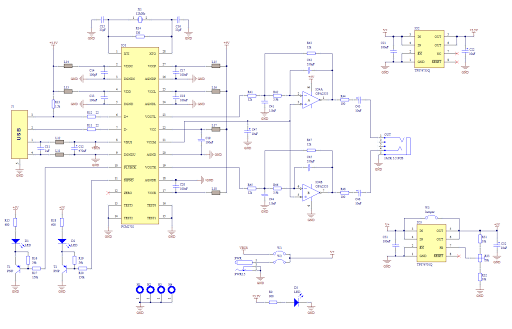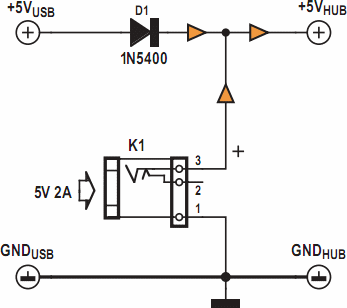
8051 USB PROGRAMMER

The circuit utilizes RS232 for interfacing with a PC. It is a straightforward design that functions effectively with a computer. Power can be supplied either from a USB port or an external 5V source. The crystal oscillator used in the AT89C2051 is critical and must be set to 11.0592 MHz. The AT89C2051 microcontroller is programmed with firmware necessary for RS232 communication with the PC. The assembly of the circuit requires burning the firmware onto the AT89C2051, which necessitates a conventional parallel programmer. A 40-pin ZIF socket is recommended for the microcontroller. The firmware (.HEX) file is available in the software folder, along with all necessary documents and files. If the computer fails to detect the kit, it is advised to check all connections on the board. The design aims to create a jumper-less circuit. Additionally, the voltage level at the two pins of the crystal should be approximately 0.7 - 0.27V. Upon the first run of the software, it searches for a valid programmer on COM1. If the programmer is connected to a different COM port, an error message will appear; the correct port can be specified in the application settings. In this circuit, power is drawn from the USB port, eliminating the need for an external power supply. An LED connected to pin P2.7 is included for testing purposes, and a program can be written to toggle the LED on and off in sinking mode. The FT232 chip is an SMD located on the underside of the board, with only two ICs visible on the surface.
The RS232 interface circuit is designed to facilitate communication between a microcontroller and a PC, leveraging the AT89C2051 microcontroller as the core processing unit. The choice of the crystal oscillator at 11.0592 MHz is significant due to its ability to provide a stable clock frequency necessary for reliable serial communication. The circuit can be powered directly from a USB port, which simplifies the design by removing the need for an external power supply.
The firmware programmed into the AT89C2051 enables the microcontroller to handle RS232 communication protocols, allowing data to be transmitted and received effectively. The use of a 40-pin ZIF socket for the microcontroller ensures ease of programming and replacement, as it allows for quick insertion and removal without the risk of damaging the pins.
For troubleshooting, the circuit design incorporates a jumper-less configuration, which minimizes the potential for connection errors. Voltage checks at the crystal pins are essential for confirming the proper operation of the oscillator. The software's initial search for a programmer on COM1 highlights the importance of correctly configuring the communication settings, ensuring that the application can interface with the microcontroller seamlessly.
The inclusion of an LED connected to the microcontroller serves as a practical diagnostic tool. By writing a simple program to control the LED, users can verify that the microcontroller is functioning as intended. The FT232 chip, which is crucial for converting USB signals to RS232 levels, is strategically placed on the bottom side of the board, allowing for a compact design while maintaining accessibility for connections.
Overall, this RS232 interfacing circuit exemplifies an efficient and effective approach to microcontroller communication with a PC, suitable for various applications in embedded systems.The above circuit uses RS232 for interfacing with PC. It is very simple circuit & works very well with PC. Power is drawn from usb port OR needs external supply of 5V. The value of the crystal is very critical at AT89C2051 and must be 11. 0592MHz. Here AT89C2051 is loaded with firmware required for RS232 communication with PC. Assemble the circuit a nd burn the firmware into an AT89C2051 (you will need a conventional parallel Programmer to Program the AT89C2051). Use the 40 pin ZIF socket for microcontroller. The firmware(. HEX) file is in the Software folder. All the required documents and Files are attatched. 1) Don`t panic if computer is not able to detect kit Please check all the connections on the board. While designing circuit manage to make jumper-less circuit. 4) Check voltage level at the two pins of the crystals it should be approx. 0. 7 - 0. 27V. When you run the software for the first time it looks for a valid programmer on COM1. If the Programmer is connected to say COM2 you will receive an error message but when the application starts select Options->Settings on the Menu and specify the correct COM Port.
In this circuit power is drawn from usb port itself, so no need of external power supply. Led at the bottom is connected to p2. 7 for testing purpose. you can write program to turn on & off the led. led is connected in sinking mode. FT232 is an SMD, its on the bottom side of the board so you can see only 2 ICs in the above circuit. 🔗 External reference
The RS232 interface circuit is designed to facilitate communication between a microcontroller and a PC, leveraging the AT89C2051 microcontroller as the core processing unit. The choice of the crystal oscillator at 11.0592 MHz is significant due to its ability to provide a stable clock frequency necessary for reliable serial communication. The circuit can be powered directly from a USB port, which simplifies the design by removing the need for an external power supply.
The firmware programmed into the AT89C2051 enables the microcontroller to handle RS232 communication protocols, allowing data to be transmitted and received effectively. The use of a 40-pin ZIF socket for the microcontroller ensures ease of programming and replacement, as it allows for quick insertion and removal without the risk of damaging the pins.
For troubleshooting, the circuit design incorporates a jumper-less configuration, which minimizes the potential for connection errors. Voltage checks at the crystal pins are essential for confirming the proper operation of the oscillator. The software's initial search for a programmer on COM1 highlights the importance of correctly configuring the communication settings, ensuring that the application can interface with the microcontroller seamlessly.
The inclusion of an LED connected to the microcontroller serves as a practical diagnostic tool. By writing a simple program to control the LED, users can verify that the microcontroller is functioning as intended. The FT232 chip, which is crucial for converting USB signals to RS232 levels, is strategically placed on the bottom side of the board, allowing for a compact design while maintaining accessibility for connections.
Overall, this RS232 interfacing circuit exemplifies an efficient and effective approach to microcontroller communication with a PC, suitable for various applications in embedded systems.The above circuit uses RS232 for interfacing with PC. It is very simple circuit & works very well with PC. Power is drawn from usb port OR needs external supply of 5V. The value of the crystal is very critical at AT89C2051 and must be 11. 0592MHz. Here AT89C2051 is loaded with firmware required for RS232 communication with PC. Assemble the circuit a nd burn the firmware into an AT89C2051 (you will need a conventional parallel Programmer to Program the AT89C2051). Use the 40 pin ZIF socket for microcontroller. The firmware(. HEX) file is in the Software folder. All the required documents and Files are attatched. 1) Don`t panic if computer is not able to detect kit Please check all the connections on the board. While designing circuit manage to make jumper-less circuit. 4) Check voltage level at the two pins of the crystals it should be approx. 0. 7 - 0. 27V. When you run the software for the first time it looks for a valid programmer on COM1. If the Programmer is connected to say COM2 you will receive an error message but when the application starts select Options->Settings on the Menu and specify the correct COM Port.
In this circuit power is drawn from usb port itself, so no need of external power supply. Led at the bottom is connected to p2. 7 for testing purpose. you can write program to turn on & off the led. led is connected in sinking mode. FT232 is an SMD, its on the bottom side of the board so you can see only 2 ICs in the above circuit. 🔗 External reference





